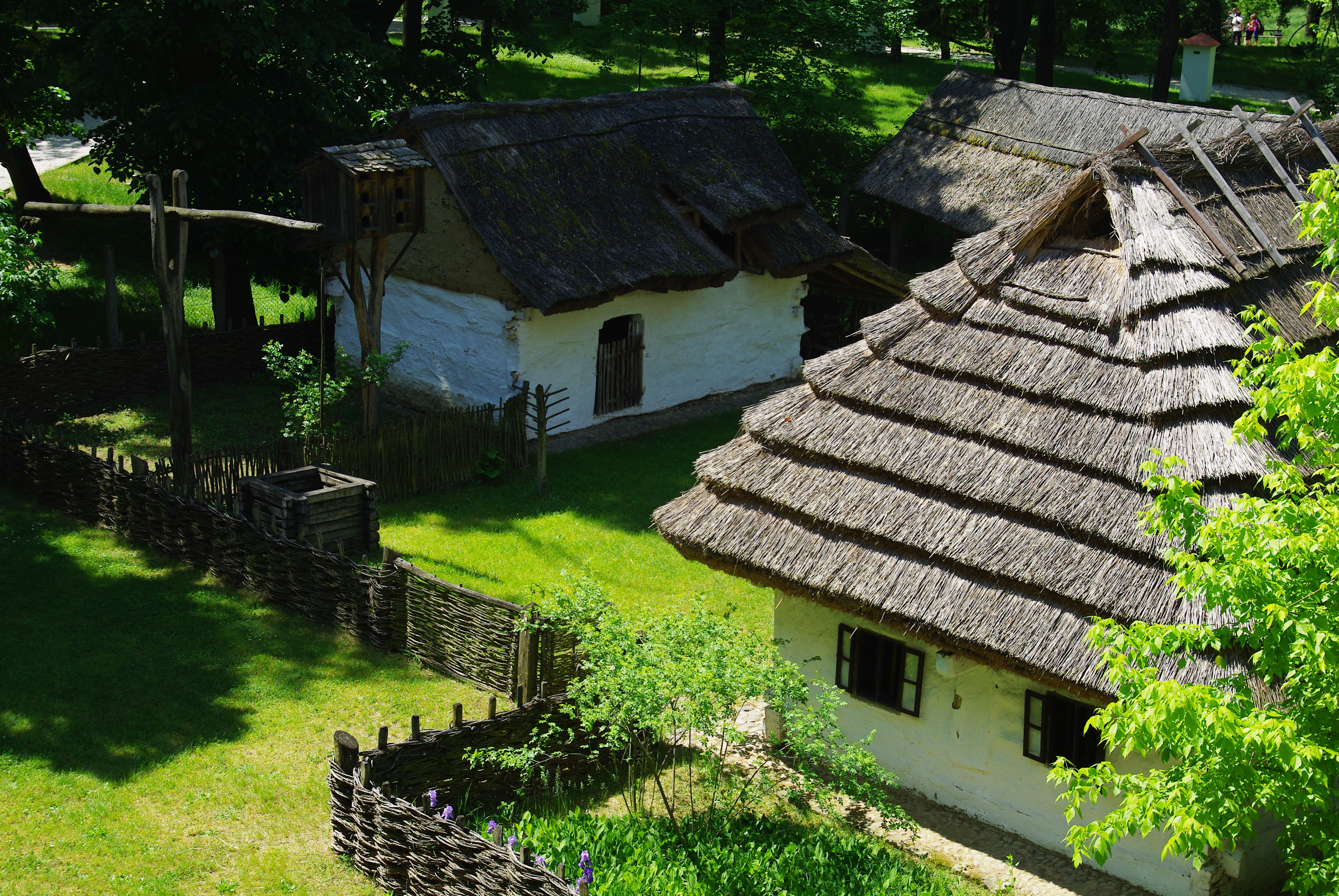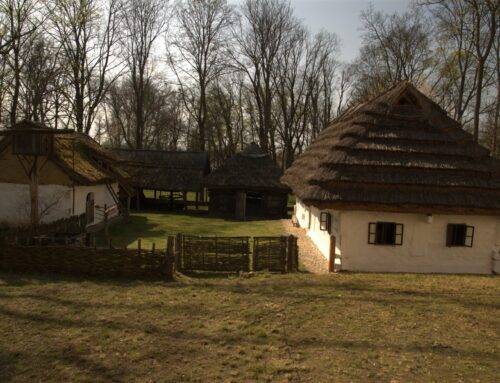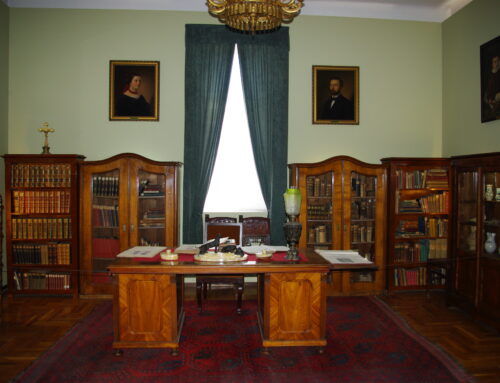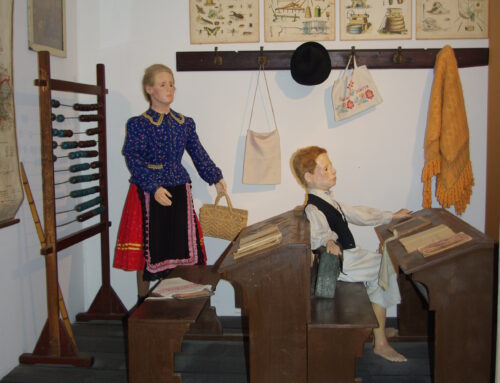Az 1930-as évek elején, amikor már a hagyományos népi építészet utolsó emlékei is pusztulásnak indultak – Nógrád megye főispánja, dr. Soldos Béla törekvése folytán – a balassagyarmati Nagy Iván Múzeum (ma Palóc Múzeum) udvarán szabadtéri gyűjteményt nyitottak meg. A gyűjteményről 1933-ban “Palóc faház és udvar a Múzeum mögött” ill. “Néhány szó a palóc faházról” címmel Bátky Zsigmond és Ébner Sándor emlékezett meg a Nógrádi Hírlapban. Az első magyar szabadtéri állandó kiállítás ekkor még csak egy lakóházból állt, a cikkek szerzőinek javaslata alapján azonban hamarosan egész gazdasági udvarrá bővült.
A szabadtéri múzeum magját képező faházat 1932-ben Karancskesziből (Széchenyi u. 7. számú ház helyéről) szállították Balassagyarmatra. Gazdájától, Mákos Józseftől 350 pengőért vásárolták meg. A hagyomány alapján a 150-200 évesre becsült faházat darabjaira bontva, hét szekér szállította a múzeum udvarára, ahol Berta András karancskeszi ácsmester állította össze eredeti formájának megfelelően.
A faistálló a 19. század elején még mint malom működött Bocsárlapujtőn. Az épületet később alig változtatott formában, istállónak használták, míg 1933-ban Balassagyarmatra nem került.
1934-ben a gyűjtemény egy patvarci származású fiókos fapajtával bővült. A pajta az istállóhoz hasonlóan a 19. század elején készült. Belsejében egy szintén patvarci eredetű 1872-re datált olajütőt helyeztek el.
A kis skanzen a második világháborúig állt nyitva a közönség előtt. A háborúban a pajta elpusztult, a faház megsérült, az épületek berendezése megsemmisült. A karancskeszi ház renoválására az ötvenes, a gyűjtemény helyreállítására a hatvanas évek elején került sor. Az elpusztult fapajtát 1964-ben újjal pótolták. A hagyomány szerint a 200-250 évesnek tartott szénapajta Márton János litkei gazda telkén állt (Dózsa u. 111.). Eredetileg istálló is kapcsolódott hozzá. A pajtában 1836-ból való szügyi borprés áll.
1966-ban, a hajdani fapajta pusztulása óta szabadon álló olajütőt egy hatlábas pajtával fedték be. Ugyanebben az évben egy Ipolyszögben honos kerítéstípussal fogták körül az immár újra teljes gazdasági udvart. A benne látható kamóskút 1967-ben készült el.
A szabadtéri gyűjtemény 1996-ban újabb építményekkel gazdagodott, nevezetesen a Szandáról behozott 1880 körül épített faluszéli kiskápolnával, valamint a Karancs-vidékéről származó 19. századi útszéli feszület rekonstrukciójával.
A hatlábas pajta kivételével, amely az olajütő védelmét szolgálja, a szabadtéri múzeum épületei legálabb 150 évvel viszik vissza látogatóikat a múltba. Mivel a 19. század elejei Nógrád megye építkezése még egységesnek mondható, bátran állíthatjuk, hogy a gyűjtemény, a különböző lelőhelyű épületek ellenére hű képet ad egy 19. század eleji nógrádi gazdasági udvarról.
A szabadtéri gyűjtemény berendezési tárgyai és azok elhelyezése azonban már a 19. század végét idézik. A belső kép kialakításában 19. század végi leírások, az idősebb generáció visszaemlékezései és néhol a második világháborút követő években még őrzött hagyományos formák voltak az irányadók. A lakóház 1964, a gazdasági épületek pedig 1967-től állnak nyitva kisebb-nagyobb szünetekkel az érdeklődők előtt.At the small open air museum next to the museum building there is a dwelling house to be visited, as well as different working buildings (stable, sheds, oil mill) and sacral monuments such as a chapel with a dressable Mary-statue and carved road cross.
The ensemble of buildings shows the typical style of architecture and way of life of the nineteenth century. The wooden house constitutes the centre of the exhibition, which originates from the Szécsényi Street 7 in Karancskeszi and was transported to Balassagyarmat in 1932. The estimated 150-200 year-old-house was first taken apart and carried on seven wagons and then unloaded at the yard of the museum. There it was assembled and rebuilt by a carpenter from Karancskeszi after the original.
The house has three parts, a hip roof covered with reeds and is characteristic for the whole Palóc area. There is no chimney, the smoke is let out through a smoke vent at the top angle of the roof; the special roof extension leads the rainwater away.
The archaic Palóc house had only one room with fireplace, which at the same time had two functions – the one of the kitchen and the other of the room. In the beginning of the eighteenth century only the first room itself of a Palóc house was called a “house”. This is where the stove stove with went-hole stood, in the centre of the room. On the inglenook the food was prepared. Opposite to the stove in the corner was the most important part of the room – the table. On the main side of the table the master of the house had his place. Along the walls settles were placed which were not only used for sitting, but also for sleeping.
Tools for baking bread were kept outside the room in the kitchen. In the small room, separated from the kitchen, kitchenware was stored. From the kitchen the small room can be reached, where the women had their unheated sleeping place and at the same time provisions, textiles and hemp were kept. There stood also the bed with richly ornamented beddings. On a pole placed over the bed the clothes and boots of the family members were hanged up. The bread was hanged up on a grating for storage as well.
Earlier one lived together with the animals under the same roof, later a simple place was built for them. The wooden stable in Balassagyarmat worked still at the beginning of the nineteenth century as a mill in Bocsárlapujtő. Later the building was used in the same form as a stable; in 1933 it was reconstructed at the museum. The stable was built in a similar way as the dwelling house – in shuttering technique. The walls were covered with mud on the inside as well as on the outside. The fodder was shovelled through a bigger hole in the attic. Before the manger, under the animals a solid wooden floor was built that covered the dung pit. The horses and cows were separated through poles.
In 1934 the ensemble of the open air museum was extended with a wooden shed from Patvarc. It originates from the first half of the nineteenth century but was destroyed in the Second World War. The shed that was rebuilt in 1946 comes from Litke and was at that time estimated to be 200-250 years old. The building is made out of massive oak beams and served as storage for the agricultural produce and tools. A wine press from Szügy demonstrates the methods of wine production in 1936.
Oil was in our region extracted out of pumpkin or hemp seeds. The small oil mill stands under a construction of six posts, which was rebuilt in 1966 and originally provided shelter for the crop.
In 1996 a copy of the small chapel in Szanda was reconstructed. The original was built in 1890, its walls are made of clay bricks and the roof was covered with shingle. The small dressable wooden statue displays the Virgin Mary with the young Jesus. It is a copy of the Mary-figure standing in the church of Tereske.
The reconstruction of a road cross was also presented in 1996 – the cross from Etes served as a pattern. They are typical sacral monuments in the Palóc area, which could be looked at as biblia pauperum, i.e. as a bible of the poor. Sometimes they are remarkable works of art, which tells about the Passion of Jesus with apocryphal pictures.




